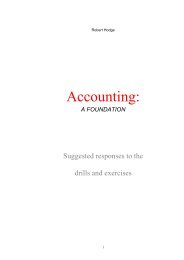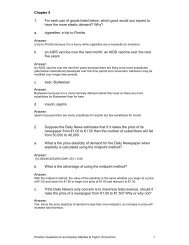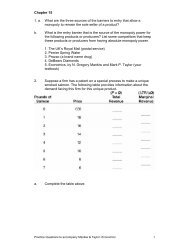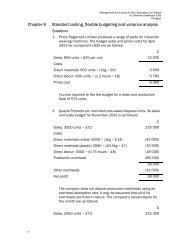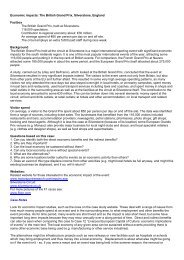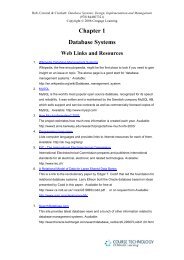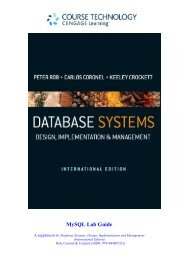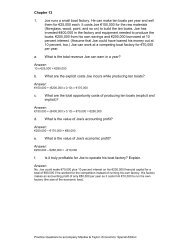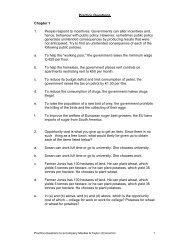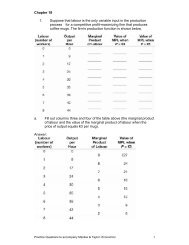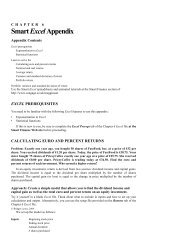CHAPTER Recruiting and selecting staff for international assignments
CHAPTER Recruiting and selecting staff for international assignments
CHAPTER Recruiting and selecting staff for international assignments
- No tags were found...
You also want an ePaper? Increase the reach of your titles
YUMPU automatically turns print PDFs into web optimized ePapers that Google loves.
31017_05_Ch05_p109-136.qxd 9/7/07 12:15 PM Page 114114 <strong>CHAPTER</strong> 5 RECRUITING AND SELECTING STAFF10 per cent of their <strong>international</strong> <strong>assignments</strong> ended in early recall. The secondsurvey by GMAC Global Relocation Services (GMAC-GRS) mentioned earlier askedresponding firms to indicate their attrition rate – that is, expatriate turnover, includingearly recall from an <strong>international</strong> assignment, <strong>and</strong> upon completion of theassignment. Again, we find that some firms (36 per cent) could not answer, as theydid not have the figures. Those that did have the in<strong>for</strong>mation indicated that 21 percent left the firm during an assignment <strong>and</strong> 23 per cent within one year of returningfrom an assignment. It would have been useful to find out why so many of theresponding firms in these two surveys did not keep records on assignmentfailures. Perhaps this is because it is not seen as an important issue?Respondents in the ORC Worldwide survey were also asked to define a failedassignment. Seventy-two per cent defined it as ‘early return of the expatriate’. Theother definitions were: ‘unmet business objectives’ (71 per cent); ‘problems atassignment location’ (49 per cent); <strong>and</strong> ‘unmet career development objectives’(32 per cent). It would appear multinationals are recognizing that there are manyaspects to a failed assignment, though it is not clear from the report if respondingfirms were separating out under-per<strong>for</strong>mance from early recall. Unmet businessobjectives, problems at assignment location <strong>and</strong> unmet career development maybe reasons <strong>for</strong> early recall rather than a definition.From the above discussion, though, we can draw a number of conclusions:1 Broadening the definition of expatriate failure beyond that of prematurereturn is warranted. Following up broad surveys with interviews withresponding firms may assist in this.2 Regardless of the definition or precise amount of ‘failure’, its very exposure asa problem has broadened the issue to demonstrate the complexity of <strong>international</strong><strong>assignments</strong>. In fact, one could argue that the so-called persistent mythof high US expatriate failure rates has been a positive element in terms of theattention that has subsequently been directed towards expatriation practices.It has certainly provoked considerable research attention into the causes ofexpatriate failure.3 The evidence about expatriate failure rates is somewhat inconclusive. Recentstudies suggest that high failure rates reported in the 1980s have not persisted<strong>for</strong> US nationals. Though recent reports do not break results down intonationality groups, US firms <strong>for</strong>m the largest group in these surveys. TheEuropean studies reported above were conducted at various intervals sinceTung’s original study, <strong>and</strong> do not include the same countries. Further, non-USresearchers have been reporting from regional or single country perspectives(see <strong>for</strong> example, Björkman <strong>and</strong> Gertsen 13 who found expatriate failure ratesof less than 5 per cent <strong>for</strong> Nordic firms; Dowling <strong>and</strong> Welch 14 reported similarresults <strong>for</strong> Australian firms).4 The above studies tend not to differentiate between types of expatriate<strong>assignments</strong>, the level of ‘<strong>international</strong>’ maturity, 15 or firm size – factors thatmay influence failure in its broadest sense.5 It may be that companies operating <strong>international</strong>ly have since become moreaware of the problems associated with expatriate failure <strong>and</strong> have learnedhow to avoid them. That is, multinationals have become more sophisticatedin their approach to IHRM activities. Benchmarking against other firmsmay have assisted in the development of an awareness of <strong>international</strong>assignment issues.
31017_05_Ch05_p109-136.qxd 9/7/07 12:15 PM Page 115<strong>CHAPTER</strong> 5 RECRUITING AND SELECTING STAFF 115What are the costs of failure? These can be both direct <strong>and</strong> indirect. Directcosts include airfares <strong>and</strong> associated relocation expenses, <strong>and</strong> salary <strong>and</strong> training.The precise amount varies according to the level of the position concerned, countryof destination, exchange rates <strong>and</strong> whether the ‘failed’ manager is replaced byanother expatriate.The ‘invisible’ or indirect costs are harder to quantify in money terms but canprove to be more expensive <strong>for</strong> the company. Many expatriate positions involvecontact with host-government officials <strong>and</strong> key clients. Failure at this level mayresult in loss of market share, difficulties with host-government officials <strong>and</strong>dem<strong>and</strong>s that expatriates be replaced with HCNs (thus affecting the multinational’sgeneral <strong>staff</strong>ing approach). The possible effect on local <strong>staff</strong> is also an indirectcost factor, since morale <strong>and</strong> productivity could suffer. 16Failure also, of course, has an effect on the expatriate concerned, who may loseself-esteem, self-confidence <strong>and</strong> prestige among peers. 17 Future per<strong>for</strong>mance maybe marked by decreased motivation, lack of promotional opportunities, or evenincreased productivity to compensate <strong>for</strong> the failure. Finally, the expatriate’s familyrelationships may be threatened. These are additional costs to organizationsthat are often overlooked.Factors moderating per<strong>for</strong>manceNaturally, the debate about the degree to which expatriate failure occurs has beenaccompanied by investigation <strong>and</strong> speculation about why failure occurs. Expatriatestend to have a higher profile, so reducing the rate of incidence is of somestrategic importance as multinationals continue to rely on expatriates <strong>and</strong> there<strong>for</strong>ewish to encourage mobility. Consequently, there has been considerable researchthat has attempted to identify factors that may moderate per<strong>for</strong>mance <strong>and</strong> affect thedecision to stay or leave the <strong>international</strong> assignment. The primary intention hasbeen to link reasons <strong>for</strong> early recall to predictors of success <strong>and</strong> thereby generateselection criteria that may assist multinationals in their <strong>staff</strong>ing decisions. Whilethe focus has predominately been on cross-cultural adjustment, other factorshave been identified, as shown in Figure 5-1. We will base our examination of theissue around this figure.Inability to adjust to the <strong>for</strong>eign cultureThis factor has been a consistent reason given <strong>for</strong> expatriate failure – <strong>and</strong> hasbeen the subject of considerable interest to researchers. Again, we must acknowledgethe pioneering contribution of Tung’s 18 study in providing the impetus <strong>for</strong>this interest. She found national differences in the responses between the US <strong>and</strong>Japanese firms. Asked to rank reasons <strong>for</strong> failure in descending order of importance,US firms ranked ‘inability of the spouse to adjust’ as the most important,whereas this was ranked fifth <strong>for</strong> the Japanese firms. For the European firms, ‘inabilityof the spouse to adjust’ was the only consistent response provided.Tung 19 noted that the relatively lower ranking of ‘inability of spouse to adjust’by Japanese respondents is not surprising, given the role <strong>and</strong> status towhich Japanese society relegates the spouse. However, other social factors maycontribute to this finding. Because of the extremely competitive nature of the
31017_05_Ch05_p109-136.qxd 9/7/07 12:15 PM Page 118118 <strong>CHAPTER</strong> 5 RECRUITING AND SELECTING STAFFDespite these limitations, however, expatriates often relate experiencing thesephases, <strong>and</strong> awareness of the psychological adjustment process can assist theexpatriate adopt positive coping behaviors. We should also note that family membersexperience the phases differently, <strong>and</strong> not necessarily move through the variousphases at the same time as each other. How accompanying family membersh<strong>and</strong>le cultural adjustment is important, as there can be a spill-over effect – anunhappy spouse may affect the expatriate’s ability to adjust, <strong>and</strong> thus impact onper<strong>for</strong>mance. For example, in their study of US managers in Japan, Korea, Taiwan<strong>and</strong> Hong Kong, Black <strong>and</strong> Stephens 25 found a high correlation between spouse<strong>and</strong> expatriate adjustment. Companies can assist in the cultural adjustment of theexpatriate <strong>and</strong> employee by using volunteer employees who have worked abroadas expatriates to ‘adopt’ a visiting family <strong>and</strong> assist in their adjustment.Length of assignmentThere is some evidence that length of assignment does contribute to adjustment<strong>and</strong> per<strong>for</strong>mance. For example, the average assignment <strong>for</strong> Japanese firms tends tobe four to five years, compared with the figure shown in Table 5.1 of 1–3 years <strong>for</strong>53 per cent of the sample of the GMAC 2005 survey. A longer assignment allowsthe expatriate more time to adjust to the <strong>for</strong>eign situation <strong>and</strong> become productive.26 Japanese firms often do not expect the expatriate to per<strong>for</strong>m up to full capacityuntil the third year; the first year of the <strong>for</strong>eign assignment is seen mainly asa period of adjustment to the <strong>for</strong>eign environment.Willingness to moveIn a situation where an employee is a reluctant expatriate or accompanied by reluctantfamily members, it is more likely that they may interpret negatively events<strong>and</strong> situations encountered in the new environment. In their survey of 405 USmanagers <strong>and</strong> their spouse/partners, Brett <strong>and</strong> Stroh 27 found a significant causalrelationship between the manager <strong>and</strong> the spouse’s willingness to move. Theyconclude that managers who are most ready <strong>for</strong> <strong>international</strong> relocations are thosewhose spouses are also supportive of that move – a not surprising finding. Otherstudies support the importance of a positive outlook. For example, Hamill 28reported that the reasons <strong>for</strong> lower British expatriate failure rates were that Britishmanagers were more <strong>international</strong>ly mobile than US managers, <strong>and</strong> that perhapsBritish companies had developed more effective expatriate policies. Dowling<strong>and</strong> Welch 29 note that the respondents in their research perceived an expatriateposting as a desirable appointment – an opportunity to travel <strong>and</strong> live overseas –leading to a positive outlook on the <strong>for</strong>eign assignment. Willingness to relocate asa predictor of success should include the views of family members <strong>and</strong> is alsoassociated with the perceived desirability of the location of the <strong>international</strong>assignment.Work environment-related factorsGregersen <strong>and</strong> Black 30 studied 220 American expatriates in four Pacific Rim countries.They found a positive correlation between what they term ‘intent to stay inthe overseas assignment’ <strong>and</strong> the PCN’s commitment to the local company,adjustment to interaction with HCNs, <strong>and</strong> adjustment to general living conditions.Adjustment to the work role itself however, was negatively associated with ‘intent
31017_05_Ch05_p109-136.qxd 9/7/07 12:15 PM Page 119<strong>CHAPTER</strong> 5 RECRUITING AND SELECTING STAFF 119to stay’. Support <strong>for</strong> these factors as moderators has come from a study by Shafferet al. 31 of expatriates working in ten US multinationals. However, Bolino <strong>and</strong>Feldman 32 extended this to include skills utilization <strong>and</strong> commitment to the organization.Their study of 268 expatriates from six Fortune 500 companies foundthat effective skill utilization was significantly related to job satisfaction, organizationcommitment <strong>and</strong> intent to finish the <strong>international</strong> assignment.Job autonomy is also a powerful factor influencing expatriate turnover. 33Another moderator is the perceived level of organizational support – from homeas well as from the host unit. 34 Further, once the expatriate has mastered, or nearlycompleted, the assigned work, other factors may surface <strong>and</strong> assume relativeimportance. For instance, if the work becomes less dem<strong>and</strong>ing <strong>and</strong> no longer sotime-consuming, the expatriate may have time to pay more attention to negativecross-cultural experiences that the family is encountering. These negative experiencescan become distorted when combined with lack of challenge at work <strong>and</strong>thus sow seeds <strong>for</strong> early recall, or under-per<strong>for</strong>mance.Selection criteriaWe now have a fuller underst<strong>and</strong>ing of the phenomenon called expatriate failure,<strong>and</strong> the multifaceted nature of <strong>international</strong> <strong>assignments</strong>, <strong>and</strong> why developingappropriate selection criteria has become a critical IHRM issue. It should be notedthat selection is a two-way process between the individual <strong>and</strong> the organization. Aprospective c<strong>and</strong>idate may reject the expatriate assignment, either <strong>for</strong> individualreasons, such as family considerations, or <strong>for</strong> situational factors, such as theperceived toughness of a particular culture.It is a challenge <strong>for</strong> those responsible <strong>for</strong> <strong>selecting</strong> <strong>staff</strong> <strong>for</strong> <strong>international</strong> <strong>assignments</strong>to determine appropriate selection criteria. Figure 5-3 illustrates the factorsinvolved in expatriate selection, both in terms of the individual <strong>and</strong> the specifics ofthe situation concerned. It should be noted that these factors are inter-related. Webase the following discussion around this Figure.Factors in expatriate selectionFigure 5-3TechnicalabilityCross-culturalsuitabilityFamilyrequirementsIndividualSituationSelection decisionCountry/culturalrequirementsLanguageMNErequirements
31017_05_Ch05_p109-136.qxd 9/7/07 12:15 PM Page 120120 <strong>CHAPTER</strong> 5 RECRUITING AND SELECTING STAFFTechnical abilityNaturally, the person’s ability to per<strong>for</strong>m the required tasks is an important consideration.Technical <strong>and</strong> managerial skills are there<strong>for</strong>e an essential criterion. Indeed,research findings consistently indicate that multinationals place heavyreliance on relevant technical skills during the expatriate selection process. 35 Forexample, the ORC Worldwide 2002 survey mentioned earlier found that 72 percent of responding firms selected assignees on the basis of skills or competencies<strong>for</strong> the job. This is not surprising given that ‘position filling’ is the most commonreason <strong>for</strong> an <strong>international</strong> assignment. Rein<strong>for</strong>cing the emphasis on technicalskills is the relative ease with which the multinational may assess the c<strong>and</strong>idate’spotential, as technical <strong>and</strong> managerial competence can be determined on thebasis of past per<strong>for</strong>mance. Since expatriates are predominantly internal recruits,personnel evaluation records can be examined <strong>and</strong> checked with the c<strong>and</strong>idate’spast <strong>and</strong> present superiors. The dilemma though is that past per<strong>for</strong>mance mayhave little or no bearing on one’s ability to achieve a task in a <strong>for</strong>eign culturalenvironment.Cross-cultural suitabilityAs we have already discussed, the cultural environment in which expatriates operateis an important factor in determining successful per<strong>for</strong>mance. Apart fromthe obvious technical ability <strong>and</strong> managerial skills, expatriates require crossculturalabilities that enable the person to operate in a new environment. Thereappears to be a consensus that desirable attributes should include cultural empathy,adaptability, diplomacy, language ability, positive attitude, emotional stability<strong>and</strong> maturity. 36In practice, while inter-cultural competence is recognized as important, it isdifficult to precisely define what this comprises, let alone assess a c<strong>and</strong>idate’ssuitability in this regard. One has to take into consideration aspects such as theindividual’s personality, attitude to <strong>for</strong>eigners, ability to relate to people fromanother cultural group <strong>and</strong> so on. Multinationals may indicate that, <strong>for</strong> example,relational abilities are an important expatriate selection criterion, but few willassess a c<strong>and</strong>idate’s relational ability through a <strong>for</strong>mal procedure such as judgementby senior managers or psychological tests. As we will discuss shortly, testingprocedures are not necessarily the answer.Family requirementsThe contribution that the family, particularly the spouse, makes to the successof the overseas assignment is now well documented, as we mentioned above inrelation to the impact of the accompanying spouse/partner on early return. Despitethe importance of the accompanying spouse/partner, as Shaffer <strong>and</strong> Harrison 37point out, the focus has been on the expatriate. From the multinational’s perspective,expatriate per<strong>for</strong>mance in the host location is the important factor. However,the interaction between expatriate, spouse/partner <strong>and</strong> family members’ variousadjustment experiences is now well documented.It should be pointed out the spouse (or accompanying partner) often carries aheavy burden. Upon arrival in the country of assignment, the responsibility <strong>for</strong> settlingthe family into its new home falls on the spouse, who may have left behind acareer, along with friends <strong>and</strong> social support networks (particularly relatives). In
31017_05_Ch05_p109-136.qxd 9/7/07 12:15 PM Page 121<strong>CHAPTER</strong> 5 RECRUITING AND SELECTING STAFF 121developing countries the employment of house servants is quite common but thisis an aspect of <strong>international</strong> living that many Westerners from developed countrieshave some difficulty adjusting to. It is often not possible <strong>for</strong> the spouse/partnerto work in the country of assignment <strong>and</strong> the well-being <strong>and</strong> education of thechildren may be an ongoing concern <strong>for</strong> the spouse. Though the majority ofspouses are female, accompanying male spouses/partners face similar problemsof adjustment. 38 In fact, when one adds cultural adjustment problems to such asituation, it is perhaps not so surprising to find that some couples seek to returnhome prematurely.Despite studies that emphasize the link between the favorable opinion of thespouse to the <strong>international</strong> assignment <strong>and</strong> expatriate adjustment, companiesappear reluctant to include the spouse/partner in the selection process, treating itin a peripheral way. 39 As a survey by Price Waterhouse 40 found:Compared to our 1995 survey, the number of companies which routinelyinterview an employee’s spouse or partner as part of the selection process hasincreased slightly, from 9% to 11%. However, overall, fewer companies involvethe spouse or partner in the selection process under any circumstances, risingfrom half in 1995 to two-thirds currently. Of the companies which do interviewthe spouse or partner, 12% interview them on their own. Given that morethan a third of the companies believe the <strong>assignments</strong> that either failed, orhad been ended prematurely, due to a spouse or partner’s difficulties withadapting to life in the host location, it is perhaps a little surprising thatcompanies are not attributing more importance to assessing their suitability.The 2002 ORC Worldwide survey did not address the involvement of the spouse/partner in the selection process, though reports that assistance was provided to helpthe accompanying person cope with the <strong>international</strong> assignment.Apart from the accompanying partner’s career, there are family considerationsthat can cause a potential expatriate to decline the <strong>international</strong> assignment.Disruption to children’s education is an important consideration, <strong>and</strong> the selectedc<strong>and</strong>idate may reject the offered assignment on the grounds that a move at thisparticular stage in his or her child’s life is inappropriate. The care of aging orinvalid parents is another consideration. While these two reasons have been notedin various studies, what has been somewhat overlooked is the issue of singleparents. Given increasing divorce rates, this may become a critical factor in <strong>assignments</strong>election <strong>and</strong> acceptance where the custody of children is involved. The associatedlegal constraints, such as obtaining the consent of the other parent to takethe child (or children) out of the home country, <strong>and</strong> visiting/access rights, mayprove to be a major barrier to the <strong>international</strong> mobility of both single mothers<strong>and</strong> single fathers.Country/cultural requirementsAs discussed in Chapter 1, <strong>international</strong> firms are usually required to demonstratethat a HCN is not available be<strong>for</strong>e the host government will issue the necessarywork permit <strong>and</strong> entry visa <strong>for</strong> the desired PCN or TCN. In some cases, the multinationalmay wish to use an expatriate <strong>and</strong> has selected a c<strong>and</strong>idate <strong>for</strong> the <strong>international</strong>assignment, only to find the transfer blocked by the host government.Many developed countries are changing their legislation to facilitate employmentrelatedimmigration which will make <strong>international</strong> transfers somewhat easier – <strong>for</strong>example the European Union Social Charter allows <strong>for</strong> free movement of citizens
31017_05_Ch05_p109-136.qxd 9/7/07 12:15 PM Page 122122 <strong>CHAPTER</strong> 5 RECRUITING AND SELECTING STAFFof member countries within the EU. It is important that HR <strong>staff</strong> keep up-to-datewith relevant legislative changes in the countries in which the MNE is involved.Our IHRM in Action Case below shows how one US MNE’s careful planningallowed it to obtain the required number of PCN visas to successfully launch itsbusiness in Australia.An important, related point is that generally a work permit is granted to the expatriateonly. The accompanying spouse or partner may not be permitted to workin the host country. Increasingly, multinationals are finding that the inability of thespouse to work in the host country may cause the selected c<strong>and</strong>idate to reject theoffer of an <strong>international</strong> assignment. If the <strong>international</strong> assignment is accepted,the lack of a work permit <strong>for</strong> the accompanying spouse or partner may cause difficultiesin adjustment <strong>and</strong> even contribute to failure. For these reasons, as reportedabove, some multinationals provide assistance in this regard.Further, the host country may be an important determinant. Some regions <strong>and</strong>countries are considered ‘hardship postings’: remote areas away from major citiesor modern facilities; or war-torn regions with high physical risk. Accompanyingfamily members may be an additional responsibility that the multinational doesnot want to bear. There may be a reluctance to select females <strong>for</strong> certain MiddleEast or South East Asian regions <strong>and</strong> in some countries a work permit <strong>for</strong> a femaleexpatriate will not be issued. These aspects may result in the selection of HCNsrather than expatriates.To overcome this problem, a group of more than 20 large multinationals (includingShell, British Airways, Unilever, PricewaterhouseCoopers <strong>and</strong> Siemens)has established an organization called ‘Permits Foundation’, 41 in an attempt topromote the improvement of work permit regulations <strong>for</strong> spouses of expatriates.It also aims to raise government awareness of the connection between work permits<strong>and</strong> employee mobility.IHRM in Action Case 5-1Citibank Plans <strong>for</strong> Changing Staffing NeedsBanks, along with oil <strong>and</strong> construction companies,remain heavy users of PCN employees, becausethese industries require very specific (sometimesfirm-specific) skills frequently not found in <strong>for</strong>eignlocations. In the mid-1980s Australia offered a onceonlyopportunity <strong>for</strong> <strong>for</strong>eign banks to enter the localmarket. Citibank already held a limited banking licensethat allowed it to operate in Australia as amerchant bank <strong>and</strong> finance company. A year be<strong>for</strong>ethe licenses were to be awarded, Citibank sent oneof its senior HR managers on a year-long assignmentto Sydney to assess the <strong>staff</strong>ing implications ofan application to the Australian government <strong>for</strong> abanking license. First, an assessment was made asto how many PCN visas would be required. Then, adetailed summary was prepared <strong>for</strong> the Australianimmigration department that demonstrated the historyof Citibank’s investment in training Australiannationals, with career examples of HCNs who werenow employed by Citibank in Australia, in other <strong>for</strong>eignlocations, <strong>and</strong> in the USA. This proved to be asuccessful strategy: Citibank received one of the 16licenses on offer <strong>and</strong> all of the PCN work permits itrequested.
31017_05_Ch05_p109-136.qxd 9/7/07 12:15 PM Page 123<strong>CHAPTER</strong> 5 RECRUITING AND SELECTING STAFF 123MNE requirementsSituational factors often have an influence on selection decisions. For example, theMNE may consider the proportion of expatriates to local <strong>staff</strong> when making selectiondecisions, mainly as an outcome of its <strong>staff</strong>ing philosophy. However, operationsin particular countries may require the use of more PCNs <strong>and</strong> TCNs thanwould normally be the case, as multinationals operating in parts of Eastern Europe<strong>and</strong> China are discovering. This will affect the selection ratio – that is, PCN:TCN:HCN. Other situational factors include the following:● The mode of operation involved. Selecting <strong>staff</strong> to work in an <strong>international</strong>joint venture may involve major input from the local partner, <strong>and</strong> could beheavily constrained by the negotiated agreement on selection processes. 42● The duration <strong>and</strong> type of the assignment. 43 Family members tend not toaccompany an expatriate when the assignment is only <strong>for</strong> three to six months,so family requirements would not normally be a relevant factor in theselection decision in such cases.● The amount of knowledge transfer inherent in the expatriate’s job in the<strong>for</strong>eign operation. If the nature of the job is to train local <strong>staff</strong>, then the MNEmay include training skills as a selection criterion.LanguageThe ability to speak the local language is an aspect often linked with cross-culturalability. However, we have chosen to stress language as situation-determined interms of its importance as a factor in the selection decision. Language skillsmay be regarded as of critical importance <strong>for</strong> some expatriate positions, but lesserin others, though some would argue that knowledge of the host country’s languageis an important aspect of expatriate per<strong>for</strong>mance, regardless of the level ofposition.Differences in language are recognized as a major barrier to effective crossculturalcommunication. 44 Yet, in terms of the other selection criteria we have examinedabove, from the multinational’s perspective, language is placed lowerdown the list of desirable attributes. For example, the ORC Worldwide survey resultsrank language ability as the fifth most important selection criteria. In the past,US multinationals have tended to place a relatively low importance on <strong>for</strong>eignlanguage skills. For example, in a 1990 study of US multinationals, Fixman 45 foundthat <strong>for</strong>eign language skills were rarely considered an important part of <strong>international</strong>business success. She comments: ‘Language problems were largely viewedas mechanical <strong>and</strong> manageable problems that could be solved individually’. Thisview is also confirmed by the consistent <strong>and</strong> relatively poor per<strong>for</strong>mance of youngAmericans on polls of geographic literacy sponsored by the National GeographicEducation Foundation. In the most recent 2006 poll 46 of young American adultsbetween the ages of 18 <strong>and</strong> 24 the following results were reported:● 50 per cent of the sample thought it was ‘important but not absolutelynecessary’ to know where countries in the news are located.● 75 per cent did not know that a majority of Indonesia’s population of245 million is Muslim (making it the largest Muslim country in the world).● 74 per cent of the sample thought that English was the most commonlyspoken language in the world, rather than M<strong>and</strong>arin Chinese.
31017_05_Ch05_p109-136.qxd 9/7/07 12:15 PM Page 124124 <strong>CHAPTER</strong> 5 RECRUITING AND SELECTING STAFFThere are signs that in a post 9/11 world, the USA is beginning to refocus on someof these issues. Recently, the Committee on Education <strong>and</strong> the Work<strong>for</strong>ce of the USCongress 47 has examined the issue of <strong>international</strong> <strong>and</strong> <strong>for</strong>eign language studies<strong>and</strong> the Chair of the Committee noted that:Congress created Title VI in the National Defense Education Act of 1958 toaddress a sense of crisis caused by U.S. citizens’ lack of knowledge of othercountries <strong>and</strong> cultures. This program remains the federal government’sleading mechanism <strong>for</strong> supporting programs that produce Americans withexpertise in <strong>for</strong>eign languages <strong>and</strong> <strong>international</strong> studies, including<strong>international</strong> business . . . Continued federal support <strong>for</strong> these programsreflects the significance <strong>and</strong> growing relevance of language <strong>and</strong> area studies,diplomacy, national security, <strong>and</strong> business competitiveness.This level of commitment is encouraging, but as we noted in Chapter 1, the task of<strong>international</strong>izing business education in the USA is a large one <strong>and</strong> will requireconsiderable resources <strong>and</strong> persistence <strong>for</strong> significant progress to be made.Another component to language as a situation factor in the selection decision isthe role of the common corporate language. As previously discussed, many multinationalsadopt a common corporate language as a way of st<strong>and</strong>ardizing reportingsystems <strong>and</strong> procedures. This is not, perhaps, an issue <strong>for</strong> PCN selection withinmultinationals from the Anglo-Saxon world (Britain, the USA, Canada, Australia<strong>and</strong> New Zeal<strong>and</strong>) where the chosen corporate language remains the same as thatof the home country. However, it becomes an expatriate selection issue <strong>for</strong> multinationalsfrom non-English-speaking countries that adopt English as the corporatelanguage, unless the posting is to a country with a shared language. For instance,a Spanish multinational, using Spanish as the corporate language, <strong>selecting</strong> a PCNto head its new subsidiary in Mexico, does not face the same language issue as aSpanish multinational, with English as its corporate language, <strong>selecting</strong> a PCN toits US facility. For the latter, fluency in English would be required. Lack of fluencyin the corporate language, there<strong>for</strong>e, can be a selection barrier. Prospective c<strong>and</strong>idatesmay be eliminated from the potential pool due to a lack of at least competencyin the common language. 48 Language ability there<strong>for</strong>e may limit the MNE’sability to select the most appropriate c<strong>and</strong>idate.The use of selection testsAlthough there is a consensus among scholars <strong>and</strong> practitioners that personalcharacteristics (or traits) are important, there is considerable debate about howsuch personal characteristics can be reliably <strong>and</strong> accurately measured. Personality<strong>and</strong> psychological tests have been used in the selection process, but the effectivenessof such tests as predictors of cultural adjustment is questioned. For example,Torbiörn 49 comments that though desirable personality traits are specified <strong>and</strong> recommended,the tests or criteria to assess these traits are seldom convincingly validated.Likewise, Willis 50 states that if tests are used they should be selected withcare <strong>and</strong> regard <strong>for</strong> reliability <strong>and</strong> validity because, while some tests may be usefulin suggesting potential problems, there appears to be little correlation betweentest scores <strong>and</strong> per<strong>for</strong>mance. He further adds that most of the relevant tests havebeen devised in the USA <strong>and</strong>, there<strong>for</strong>e, may be culture-bound. Use of such testswithout careful modification on non-American nationals adds another questionmark to their reliability <strong>and</strong> validity as predictors of expatriate success. It is importantthat HRM <strong>staff</strong> in all locations are aware of the debate surrounding the use of
31017_05_Ch05_p109-136.qxd 9/7/07 12:15 PM Page 125<strong>CHAPTER</strong> 5 RECRUITING AND SELECTING STAFF 125selection tests, particularly the culture-bound nature of psychometric tests designed<strong>for</strong> PCNs.Another constraint is that in some countries (the UK <strong>and</strong> Australia <strong>for</strong> instance)there is controversy about the use of psychological tests. 51 There is also a differentpattern of usage across countries – the use of such tests is very low in Germany. 52The 1997/98 Price Waterhouse survey reported only 12 per cent used <strong>for</strong>malassessment centers, <strong>and</strong> some companies ‘indicated through their comments thatthey also use psychometric tests’. The majority of respondents (85 per cent)mainly assessed expatriate suitability through the traditional interview process.More recent surveys have not addressed this aspect of selection. The difficulty ofpredicting success, then, seems to be related to the lack of valid <strong>and</strong> reliablescreening devices to identify, with certainty, managers who will succeed in a <strong>for</strong>eignassignment. The crucial variables affecting the adjustment of the individual<strong>and</strong> family are not only difficult to identify or measure, but the complex relationshipbetween personality factors <strong>and</strong> ability to adjust to another culture is not wellunderstood. 53Another drawback of expatriate selection based on traits or characteristics is thesubjective nature of the scoring of abilities, especially those classified as personal<strong>and</strong> environmental characteristics. Nevertheless, models derived from this approachhave value in that they provide some guidelines that can be applied duringthe selection process, rather than mere reliance on the potential manager’s domesticrecord as a predictor. 54 One such model is that offered by Mendenhall <strong>and</strong>Oddou. 55 They propose a four-dimensional approach that attempts to link specificbehavioral tendencies to probable overseas per<strong>for</strong>mance:● The self-oriented dimension – the degree to which the expatriate expresses anadaptive concern <strong>for</strong> self-preservation, self-enjoyment <strong>and</strong> mental hygiene.● The perceptual dimension – the expertise the expatriate possesses inaccurately underst<strong>and</strong>ing why host nationals behave the way they do.● The others-oriented dimension – the degree to which the expatriate isconcerned about host-national co-workers <strong>and</strong> desire to affiliate with them.● The cultural-toughness dimension – a mediating variable that recognizes thatacculturation is affected by the degree to which the culture of the host countryis incongruent with that of the home country.The evaluation of the c<strong>and</strong>idate’s strengths <strong>and</strong> weaknesses on these four dimensions,Mendenhall <strong>and</strong> Oddou suggested, will focus appropriate attention on crossculturalability <strong>and</strong> behavior, thus complementing technical ability assessment.Equal employment opportunity issuesIn the recruitment <strong>and</strong> selection process, multinationals must address the issue ofequal employment opportunity (EEO) <strong>for</strong> employees in all employment locations.This involves taking into consideration the increasingly conflicting national lawson employment. As Jain, Sloane <strong>and</strong> Horwitz 56 mention, m<strong>and</strong>atory retirement<strong>and</strong> hiring ages are illegal in some countries such as the USA <strong>and</strong> some other countriesbut remain a legal requirement in other countries.Determining which law applies where, <strong>and</strong> which has precedence, is a problemwithout a specific solution. The USA has a comprehensive statute (Title VIIof the Civil Rights Act of 1964) to cover many EEO situations. In 1991 the USSupreme Court 57 held that this Act does not apply outside the territorial borders
31017_05_Ch05_p109-136.qxd 9/7/07 12:15 PM Page 126126 <strong>CHAPTER</strong> 5 RECRUITING AND SELECTING STAFFof the USA. The case involved an American citizen who claimed that he had beenillegally discriminated against while working overseas <strong>for</strong> a US corporation. Anaturalized citizen born in Lebanon, the plaintiff began working <strong>for</strong> AramcoCorporation in Texas in 1979 <strong>and</strong> was transferred by the company to work inSaudi Arabia in 1980, where he worked until 1984, when he was discharged. TheCourt rejected the person’s claim that he had been harassed <strong>and</strong> ultimately dischargedby Aramco Corporation on account of his race, religion <strong>and</strong> national origin.This decision had important implications <strong>for</strong> the status <strong>and</strong> protection ofAmericans working abroad <strong>for</strong> US firms <strong>and</strong> the Civil Rights Act was subsequentlyamended by the US Congress in 1991 to extend protection to all US citizensworking overseas.Equal employment opportunity laws are expressions of social values with regardto employment <strong>and</strong> reflect the values of a society or country. 58 In parts of theMiddle East, Africa, Asia <strong>and</strong> Latin America, women are perceived to have a lowersocial status <strong>and</strong> are not universally employed. On the other h<strong>and</strong>, with theincreasing rate of female entry into the work<strong>for</strong>ce, many Western countries haveintroduced legislation to cover sex discrimination. Multinationals must be awareof legislation <strong>and</strong> ensure subsidiary compliance where appropriate in <strong>selecting</strong>expatriates.Expatriate selection in practice: the role of the coffee machineAs we indicated at the beginning of the section on selection criteria, most multinationalsadmit that technical <strong>and</strong>/or managerial skills are the dominant, sometimesonly, criteria used. We have suggested that reliance on technical skills is mainly dueto the fact that most <strong>international</strong> <strong>assignments</strong> are ‘position filling’. Of the factorsoutlined in Figure 5-3 above, technical skills is perhaps the easiest to measure. Itcould be argued that Figure 5-3 represents a best practice or ideal selection modelwhich many MNEs do not in fact use. Harris <strong>and</strong> Brewster 59 have argued that expatriateselection, in reality, often tends to be an ad hoc process which they describeas the ‘coffee-machine’ system.Harris <strong>and</strong> Brewster suggest that executives chatting around the coffee-machine(or water cooler) can start the selection process through a casual conversationabout an assignment need confronting one of them. Another executive can volunteerthe name of a potential expatriate thus starting an in<strong>for</strong>mal short list ofc<strong>and</strong>idates. What happens next, according to Harris <strong>and</strong> Brewster, is that themultinational’s processes are then activated to legitimize the decision that has, ineffect, already been taken around the coffee machine. Harris <strong>and</strong> Brewster relatethat this process was the most common <strong>for</strong>m of selection process they encounteredin their study of UK firms. They then derived a typology of selection systemsto explain variations found in the way expatriate selection is conducted, detailedin Table 5-2.Harris <strong>and</strong> Brewster regard the coffee-machine scenario as an example of thein<strong>for</strong>mal/closed cell in their typology. It is of course possible to find examples of<strong>for</strong>mal, open selection processes in firms as well as in<strong>for</strong>mal or closed systems.Harris <strong>and</strong> Brewster note that the process can be influenced by the maturity of themultinational, its stage in the <strong>international</strong>ization process <strong>and</strong> its size or industry.The type of position involved, the role of the HR function in the process <strong>and</strong>whether the multinational is reactive rather than proactive where <strong>international</strong> <strong>assignments</strong>election is involved remain key factors in how selection processes workin multinationals.
31017_05_Ch05_p109-136.qxd 9/7/07 12:15 PM Page 127<strong>CHAPTER</strong> 5 RECRUITING AND SELECTING STAFF 127Harris <strong>and</strong> Brewster’s selection typologyTable 5-2FormalIn<strong>for</strong>malOPEN • Clearly defined criteria • Less defined criteria• Clearly defined measures• Less defined measures• Training <strong>for</strong> selectors• Limited training <strong>for</strong> selectors• Open advertising of vacancy • No panel discussions(internal/external)• Open advertising of vacancy• Panel discussions• RecommendationsCLOSED • Clearly defined criteria • Selectors’ individual• Clearly defined measurespreferences determine selection• Training <strong>for</strong> selectorscriteria <strong>and</strong> measures• Panel discussions• No panel discussions• Nominations only• Nominations only(networking/reputation)(networking/reputation)Source: H. Harris <strong>and</strong> C. Brewster, ‘The Coffee-Machine System: How International Selection Really Works’,International Journal of Human Resource Management, Vol. 10, No. 3 (1999), p. 493. Reproduced withpermission.Dual career couplesSo far, we have focused on <strong>selecting</strong> suitable c<strong>and</strong>idates <strong>for</strong> <strong>international</strong> <strong>assignments</strong>.We will now consider an emerging constraint – the dual career couple – onthe available pool of c<strong>and</strong>idates, thus hindering the recruitment <strong>and</strong> selectionprocess. The rise in dual career couples, along with the aging population <strong>and</strong>other family-related situations, combine to make more people immobile. Employeesare prepared to state the grounds <strong>for</strong> refusal as ‘family concerns’. That this hasbecome more acceptable as a reason reflects a significant shift in thinking aboutthe role of non-work aspects impinging on work-related matters.The increase in the number of dual-career couples is a worldwide trend, onethat is posing a dilemma <strong>for</strong> both companies <strong>and</strong> employees alike. This is not surprisinggiven that accepting a traditional <strong>international</strong> assignment will impactupon the career of the potential c<strong>and</strong>idate’s spouse or partner. The ORC Worldwide2002 survey focused on the issue of dual careers <strong>and</strong> <strong>international</strong> <strong>assignments</strong>. Amajor finding was that spousal or dual career issues were the most common reasons<strong>for</strong> rejecting <strong>international</strong> <strong>assignments</strong> reported by North American <strong>and</strong> Europeanfirms, but were rarely cited by Asian firms. Rather, concern <strong>for</strong> children <strong>and</strong> ageingparents were barriers to assignment acceptance <strong>for</strong> this group. Likewise, theGMAC-GRS 2005 survey cites spouse career concerns as the third most frequentreason <strong>for</strong> assignment refusal.Multinationals are being <strong>for</strong>ced to select from a diminishing pool of c<strong>and</strong>idateswho may be less qualified. This has strategic implications <strong>for</strong> <strong>staff</strong>ing policies, <strong>and</strong>may be a reason why more TCNs are being utilized. As we noted when discussing
31017_05_Ch05_p109-136.qxd 9/7/07 12:15 PM Page 128128 <strong>CHAPTER</strong> 5 RECRUITING AND SELECTING STAFFthe expatriate profile in Table 5-1, 27 per cent of expatriates were TCNs in the2005 GMAC survey. While cost containment remains a major driver of localization(that is, replacing expatriates with HCNs), <strong>staff</strong> availability is also a factor. 60Reflecting this global trend, the impact of the accompanying spouse/partner’scareer orientation upon the <strong>international</strong> assignment is an emerging area of research.It seems that career orientation not only affects the couple’s willingness tomove, but also may negatively affect per<strong>for</strong>mance <strong>and</strong> retention in the <strong>for</strong>eignlocation. 61 Some multinationals are endeavoring to come up with solutions to thedual-career challenge. These can be divided into two categories: finding alternativearrangements <strong>and</strong> making the <strong>assignments</strong> more ‘family-friendly’.Alternative assignment arrangementsThere are a number of alternative assignment arrangements that can be identifiedin <strong>international</strong> <strong>staff</strong>ing:Short-term <strong>assignments</strong>. In the ORC Worldwide 2002 survey, 72 per cent ofresponding firms used short-term <strong>assignments</strong> (compared with 26 per cent in a1996 ORC survey) as an alternative means of satisfying the <strong>international</strong> assignmentneed.Commuter <strong>assignments</strong> (sometimes referred to as ‘commuter marriages’). Thespouse may decide to remain in the home country, <strong>and</strong> the couple works out waysto maintain the relationship with the help of the firm. Alternatively, couples maymove to jobs in adjoining countries, or within the same geographical region tomake commuting (relationship-maintenance) easier. Multinationals often adjustcompensation benefits to fit with agreed arrangements. The ORC survey foundthat 46 per cent of responding firms had such arrangements (compared with19 per cent in 1996).Other arrangements.findings were:Other arrangements included in the ORC 2002 report● Unaccompanied <strong>assignments</strong> 50 %● Replacing <strong>assignments</strong> with business travel 57 %● Virtual <strong>assignments</strong> 16 %.Only 23 per cent of respondents in a similar study by ORC Worldwide in 1995reported the use of unaccompanied <strong>assignments</strong>.There has been little attention given to the advantages <strong>and</strong> disadvantages ofthese non-st<strong>and</strong>ard <strong>assignments</strong> in terms of the individual employees, theirspouses <strong>and</strong> the strategic objectives that prompt the use of <strong>international</strong> ratherthan local <strong>staff</strong>. While these arrangements may have short-term benefits in overcomingreluctance to move, how effective they will be in encouraging dual careercouples to accept <strong>international</strong> <strong>assignments</strong> over time is yet to be determined.Family-friendly policiesInter-company networking. Here the multinational attempts to place the accompanyingspouse or partner in a suitable job with another multinational – sometimes
31017_05_Ch05_p109-136.qxd 9/7/07 12:15 PM Page 129<strong>CHAPTER</strong> 5 RECRUITING AND SELECTING STAFF 129in a reciprocal arrangement. To illustrate: a US multinational may enter intoan agreement with a German multinational also operating in, say, China, thatthey find a position within their respective Chinese facilities <strong>for</strong> each other’saccompanying partner (that is, ‘you find my expatriate’s spouse a job <strong>and</strong>work visa, <strong>and</strong> I will do likewise <strong>for</strong> you’). Alternatively, a local supplier, distributor,or joint venture partner may agree to employ the accompanying spouse/partner.Job-hunting assistance. Here the multinational provides spouse/partner assistancewith the employment search in the host country. This may be through employmentagency fees, career counselling, or simply work permit assistance. Somemay provide a fact-finding trip to the host location be<strong>for</strong>e the actual assignment.The 2005 GMAC-GRS survey reports that 31 per cent of responding firms assistedin finding the accompanying spouse/partner employment by funding job-finding<strong>and</strong> executive search fees.Intra-company employment. This is perhaps a logical but often a somewhat difficultsolution. It means sending the couple to the same <strong>for</strong>eign facility, perhapsthe same department. Not all multinationals (or all couples) are com<strong>for</strong>table withthe idea of having a husb<strong>and</strong> <strong>and</strong> wife team in the same work location <strong>and</strong> therecan often be difficulties obtaining work visas <strong>for</strong> such arrangements.On-assignment career support. Motorola 62 is an example of how a multinationalmay assist spouses to maintain <strong>and</strong> even improve career skills through whatMotorola calls its Dual-Career Policy. This consists of a lump-sum payment <strong>for</strong> educationexpenses, professional association fees, seminar attendance, languagetraining to upgrade work-related skills <strong>and</strong> employment agency fees. There areconditions attached, such as the spouse must have been employed be<strong>for</strong>e the assignment.Thus, if the spouse is unable to find suitable employment, the time canbe spent on career development activities.Other examples of on-assignment assistance are providing help in establishingcontacts <strong>and</strong> paying <strong>for</strong> lost spouse income. The idea is to maintain skills so thatthe spouse may find work upon re-entry into the home country. These attemptsdemonstrate that creative thinking can assist multinationals to overcome thispotential barrier. It is not possible to comment with authority on how effective theabove assistance schemes are in terms of overcoming the dual career barrier. However,it is clear that multinationals are attempting to address the issue <strong>and</strong> createsolutions <strong>for</strong> this barrier to mobility.Are female expatriates different?Our final issue in terms of selection <strong>for</strong> <strong>international</strong> <strong>assignments</strong> is related to gender.The typical expatriate tends to be male: 23 per cent in the GMAC-GRS 2005survey were females, 14 per cent in the ORC 2002 survey. The authors of boththese surveys make the point that the proportion of females is increasing. For example,the ORC report compares the 2002 situation to that of their 1992 survey
31017_05_Ch05_p109-136.qxd 9/7/07 12:15 PM Page 130130 <strong>CHAPTER</strong> 5 RECRUITING AND SELECTING STAFFwhere only 5 per cent of expatriates were female. One can go further back to a1984 article, in which Adler 63 reported a survey of <strong>international</strong> HR practices inover 600 US <strong>and</strong> Canadian companies that found only 3 per cent of the 13338 expatriatesidentified were female. She found that female expatriates tended to beemployed by companies with over 1000 employees in the banking, electronics,petroleum <strong>and</strong> publishing industries. It has been argued that as the proportion ofwomen in the domestic work<strong>for</strong>ce continues to increase, <strong>and</strong> as <strong>international</strong> experiencebecomes an essential criterion <strong>for</strong> career progression within multinationals,we will see more <strong>international</strong> managers who are female.Over the past decade or so, researchers have attempted to discover why sofew expatriates are female. Is it because they were unwilling to relocate? Is itattitudinal? Does it reflect a somewhat externalized belief that men in some cultures,such as certain Asian countries, do not like reporting to female managers,particularly <strong>for</strong>eign women, <strong>and</strong> there<strong>for</strong>e women should not be posted overseas,creating what has been referred to as ‘the glass border that supports theglass ceiling’.A number of studies challenge some of the attitudes regarding the suitability offemales <strong>for</strong> <strong>international</strong> <strong>assignments</strong>. For example, Stroh, Varma <strong>and</strong> Valy-Durbin 64 found that US <strong>and</strong> Canadian women are interested in <strong>and</strong> likely toaccept <strong>international</strong> <strong>assignments</strong>, though there are variations between thosewith children <strong>and</strong> those without. However the women in this study tended tobelieve that their firms were hesitant to ask them to accept an <strong>international</strong>assignment, though supervisors (whether male or female) did not necessarilyshare that belief. Further, per<strong>for</strong>mance of female expatriates was found initiallyto be affected by host-country prejudice regarding the role of women in certaincountries – considered as culturally tough assignment locations. However, thelonger the women were on such <strong>assignments</strong>, the less they perceived that prejudicewas a barrier to effectiveness. Caligiuri <strong>and</strong> Tung, 65 in their study of female<strong>and</strong> male expatriates in a US-based multinational found that females can per<strong>for</strong>mequally as well as their male counterparts regardless of a country’s attitude towardwomen in managerial positions.Taking a different approach in her study of Austrian female expatriates,Fischlmayr 66 used the concepts of external <strong>and</strong> self-established barriers to explorewhy women are under-represented in <strong>international</strong> <strong>assignments</strong>. These are listed inTable 5-3.Through 21 interviews with HR managers <strong>and</strong> female expatriates in Austrianmultinationals from various industries <strong>and</strong> positions, Fischlmayr found that attitudesof HR directors were a major barrier to the selection of female expatriates,though self-established barriers were also very strong. Females in Austrian companiesoften had to specifically request an <strong>international</strong> assignment whereas theirmale colleagues were required to take <strong>international</strong> <strong>assignments</strong>. Further, somewomen regarded that their age was decisive in terms of others’ perceptions <strong>and</strong> expectationsabout their behavior. The older the woman, the easier it is. Fischlmayrconcludes that women are partly to blame <strong>for</strong> their under-representation.Mayrhofer <strong>and</strong> Scullion 67 report on the experiences of male <strong>and</strong> female expatriatesin the German clothing industry. They found that women were sentinto a diverse number of countries, including those with an Islamic influence.Overall, there were few differences in the experiences of both gender groups,though female expatriates placed more value on integration of spouse/familyissues prior to <strong>and</strong> during the assignment than did the males in the sample.
31017_05_Ch05_p109-136.qxd 9/7/07 12:15 PM Page 131<strong>CHAPTER</strong> 5 RECRUITING AND SELECTING STAFF 131Barriers to females taking <strong>international</strong> <strong>assignments</strong> Table 5-3External barriers• HR managers reluctant to select femalec<strong>and</strong>idates• Culturally tough locations or regions precludefemale expatriates• Those <strong>selecting</strong> expatriates have stereotypesin their minds that influence decisionsSelf-established barriers• Some women have limited willingnessto relocate• The dual career couple• Women are often a barrier to their owncareers by behaving according togender-based role modelsSource: Based on the literature reviewed in I.C. Fischlmayr, ‘Female Self-Perception as Barrier to InternationalCareers?’, International Journal of Human Resource Management, Vol. 13, No. 5 (2002), pp. 773–83.Assignment lengths in this industry tended to be shorter <strong>and</strong> involvedvarious <strong>for</strong>ms of non-st<strong>and</strong>ard <strong>assignments</strong>, <strong>and</strong> there were generally more femalemanagers than perhaps found in other industries. More women than menwere assigned <strong>for</strong> longer assignment terms, <strong>and</strong> these authors conclude thatthe higher proportion of women in the industry appeared to make gender lessof an issue. However, this did not apply at the top senior management positionswhere women were less represented. Mayrhofer <strong>and</strong> Scullion concludethat there are still barriers to female expatriates in terms of senior expatriatepositions.A further contribution comes from a study by Napier <strong>and</strong> Taylor 68 of female expatriatesfrom various countries working in Japan, China <strong>and</strong> Turkey. The women fellinto three categories: traditional expatriates, ‘trailers’ who were spouses/partners ofmale expatriates, <strong>and</strong> ‘independents’ – professional women who could be calledself-selected expatriates. Napier <strong>and</strong> Taylor found that gaining credibility with localclients was a major issue. Accommodating cultural differences, maintaining a sociallife <strong>and</strong> a need <strong>for</strong> appropriate interpersonal skills were important factors incoping with work dem<strong>and</strong>s. Networks became important <strong>for</strong> both business <strong>and</strong>social contexts. Being a minority (<strong>for</strong>eign females) meant higher visibility thanthey were used to <strong>and</strong> could be a positive in terms of getting access to key clients<strong>and</strong> customers.What emerges as common across the various studies on female expatriates isthat assignment location, level of organization support, spouse/partner satisfaction<strong>and</strong> inter-cultural experiences are important in terms of per<strong>for</strong>mance. Thelist of moderators is similar to those we discussed in general terms earlier inthis chapter. What does appear to differentiate female <strong>and</strong> male expatriates isthe degree to which these moderators affect individual per<strong>for</strong>mance <strong>and</strong> thevalue placed on cultural awareness training prior to the <strong>international</strong> assignment.The dual career issue may prove to be a greater barrier <strong>for</strong> female mobilityas males are more reluctant to accompany their spouse/partner.
31017_05_Ch05_p109-136.qxd 9/7/07 12:15 PM Page 132132 <strong>CHAPTER</strong> 5 RECRUITING AND SELECTING STAFFSummaryThis chapter has addressed key issues affecting recruitment <strong>and</strong> selection <strong>for</strong><strong>international</strong> <strong>assignments</strong>. We have covered:● Four myths related to the concept of a global manager: that there is auniversal approach to management; that people can acquire multiculturaladaptability <strong>and</strong> behaviors; that there are common characteristics successful<strong>international</strong> managers share; <strong>and</strong> that there are no impediments tomobility.● The debate surrounding the definition <strong>and</strong> magnitude of expatriatefailure.● Cultural adjustment <strong>and</strong> other moderating factors affecting expatriateintent to stay <strong>and</strong> per<strong>for</strong>mance. These included duration of the assignment,willingness to move <strong>and</strong> work-related factors.● Individual <strong>and</strong> situational factors to be considered in the selectiondecision. Evaluation of the common criteria used revealed the difficultyof <strong>selecting</strong> the right c<strong>and</strong>idate <strong>for</strong> an <strong>international</strong> assignment <strong>and</strong> theimportance of including family considerations in the selection process.● Dual career couples as a barrier to <strong>staff</strong> mobility, <strong>and</strong> the techniquesmultinationals are utilizing to overcome this constraint.● Female expatriates <strong>and</strong> whether they face different issues to their malecounterparts.It is also clear that, while our appreciation of the issues surrounding expatriaterecruitment <strong>and</strong> selection has deepened in the past 30 years, much remainsto be explored. The field is dominated by US research into predominantlyUS samples of expatriates, though there has been an upsurge ininterest from European academics <strong>and</strong> practitioners. Will the factors affectingthe selection decision be similar <strong>for</strong> multinationals emerging fromcountries such as China <strong>and</strong> India? If more multinationals are to encouragesubsidiary <strong>staff</strong> to consider <strong>international</strong> <strong>assignments</strong> as part of an intraorganizationalnetwork approach to management, we will need furtherunderst<strong>and</strong>ing of how valid the issues discussed in this chapter are <strong>for</strong> allcategories of <strong>staff</strong> from different country locations. It is apparent, though,that <strong>staff</strong> selection remains critical. Finding the right people to fill positions,particularly key managers – whether PCN, TCN or HCN – can determine <strong>international</strong>expansion. However, effective recruitment <strong>and</strong> selection is onlythe first step.Discussion Questions1 What is the difference between a global manager <strong>and</strong> a global mindset?2 Should multinationals be concerned about expatriate failure? If so, why?3 What are the most important factors involved in the selection decision?4 Are female expatriates different?5 Discuss the proposition that most expatriate selection decisions are madein<strong>for</strong>mally, as suggested by the ‘coffee-machine’ solution.
31017_05_Ch05_p109-136.qxd 9/7/07 12:15 PM Page 133<strong>CHAPTER</strong> 5 RECRUITING AND SELECTING STAFF 133Further ReadingBoudreau, J., Ramstad, P. <strong>and</strong> Dowling, P.J. (2003). ‘Global Talentship: Toward a Decision ScienceConnecting Talent to Global Strategic Success’, in W.H. Mobley <strong>and</strong> P.W. Dorfman (eds), Advances inGlobal Leadership, Vol. 3, Ox<strong>for</strong>d: Elsevier Science, pp. 63–99.International Studies of Management & Organization (2004). Special issue on Expatriation in theNew Millenium, guest ed. Moshe Banai, 34(3).Scullion, H. <strong>and</strong> Collings, D. (eds) (2006). Global Staffing, London: Routledge.Tarique, I., Schuler, R. <strong>and</strong> Gong, Y. (2006). ‘A Model of Multinational Enterprise Subsidiary StaffingComposition’, International Journal of Human Resource Management, 17(2): 207–24.Notes <strong>and</strong> References1 H. Scullion <strong>and</strong> D. Collings, ‘International Recruitment <strong>and</strong> Selection’, in H. Scullion <strong>and</strong>D. Collings (eds), Global Staffing (London, Routledge, 2006), pp. 59–86.2 For a recent review of the culture literature, see K. Leung, R. Bhagat, N. Buchan, M. Erez <strong>and</strong>C. Gibson, ‘Culture <strong>and</strong> International Business: Recent Advances <strong>and</strong> Their Implications <strong>for</strong>Future Research’, Journal of International Business Studies, Vol. 36, No. 4 (2005), pp. 357–78.3 F.T. Murray <strong>and</strong> A.H. Murray, ‘Global Managers <strong>for</strong> Global Businesses’, Sloan ManagementReview, Vol. 27, No. 2 (1986), pp. 75–80.4 N. Forster, ‘The Myth of the “International Manager”’, International Journal of Human ResourceManagement, Vol. 11, No. 1 (2000), pp. 126–42. See also C.A. Bartlett <strong>and</strong> S. Ghoshal, ‘The Mythof the Generic Manager: New Personal Competencies <strong>for</strong> New Management Roles’, Cali<strong>for</strong>niaManagement, Review, Vol. 40, No. 1 (1997), pp. 92–116.5 Y. Baruch, ‘No Such Thing as a Global Manager’, Business Horizons, January–February (2002),pp. 36–42.6 N. Forster, ‘The Persistent Myth of High Expatriate Failure Rates’, International Journal ofHuman Resource Management, Vol. 8, No. 4 (1997), p. 430.7 Price Waterhouse (eds), International Assignments: European Policy <strong>and</strong> Practice (London:Price Waterhouse, 1997).8 R.L. Tung, ‘Selection <strong>and</strong> Training of Personnel <strong>for</strong> Overseas Assignments’, Columbia Journalof World Business, Vol. 16, No. 1 (1981), pp. 68–78; R.L. Tung, ‘Selection <strong>and</strong> TrainingProcedures of US, European <strong>and</strong> Japanese Multinationals’, Cali<strong>for</strong>nia Management Review,Vol. 25, No. 1 (1982), pp. 57–71; <strong>and</strong> R.L. Tung, ‘Human Resource Planning in JapaneseMultinationals: A Model <strong>for</strong> US Firms?’, Journal of International Business Studies (Fall 1984),pp. 139–49.9 C. Brewster, The Management of Expatriates, Human Resource Research Centre MonographSeries, No. 2 (Bed<strong>for</strong>d: Cranfield School of Management, 1988). In a pilot study, Hamillinvestigated the IHRM practices <strong>and</strong> policies of seven British multinationals. He found that thefailure rate among British expatriates was significantly lower (less than 5 per cent) than thatreported <strong>for</strong> US multinationals ( J. Hamill, ‘Expatriate Policies in British Multinationals’, Journalof General Management, Vol. 14, No. 4 (1989), pp. 19–33; E. Marx, International HumanResource Practices in Britain <strong>and</strong> Germany (London: Anglo-German Foundation, 1996).10 A.-W. Harzing, ‘The Persistent Myth of High Expatriate Failure Rates’, International Journal ofHuman Resource Management, Vol. 6, No. 2 (1995), p. 458.11 C. Christensen <strong>and</strong> A.-W. Harzing, ‘Expatriate Failure: Time to Ab<strong>and</strong>on the Concept?’, CareerDevelopment International, Vol. 9, No. 7 (2004), pp. 616–26.12 Organizational Resource Councelors Inc, ‘Dual Careers <strong>and</strong> International Assignments Survey’(2002). The organization changed its name to ORC Worldwide in 2003.13 I. Björkman <strong>and</strong> M. Gertsen, ‘Corporate Expatriation: An Empirical Study of Sc<strong>and</strong>inavian Firms’,in ‘Proceedings of the Third Symposium on Cross-Cultural Consumer <strong>and</strong> Business Studies’,Honolulu (December 1990). Danish firms did not respond to Tung’s survey, but the Swedish <strong>and</strong>Norwegian firms did.14 P.J. Dowling <strong>and</strong> D. Welch, ‘International Human Resource Management: An AustralianPerspective’, Asia-Pacific Journal of Management, Vol. 6, No. 1 (1988), pp. 39–65. Althoughprecise records were not kept, the four companies estimated failure rates of less than 5 per cent.15 For example, Enderwick <strong>and</strong> Hodgson explain the absence of ‘expatriate failure’ in their study ofNew Zeal<strong>and</strong> firms may be due to their early stages in <strong>international</strong>ization. See P. Enderwick <strong>and</strong>D. Hodgson, ‘Expatriate Management Practices of New Zeal<strong>and</strong> Business’, International Journalof Human Resource Management, Vol. 4, No. 2 (1993), pp. 407–23.
31017_05_Ch05_p109-136.qxd 9/7/07 12:15 PM Page 134134 <strong>CHAPTER</strong> 5 RECRUITING AND SELECTING STAFF16 M.E. Mendenhall <strong>and</strong> G. Oddou, ‘The Overseas Assignment: A Practical Look’, Business Horizons(September–October, 1988), pp. 78–84.17 M. Mendenhall <strong>and</strong> G. Oddou, ‘The Dimensions of Expatriate Acculturation: A Review’, Academyof Management Review, Vol. 10 (1985) pp. 39–47.18 Tung, ‘Selection <strong>and</strong> Training Procedures’.19 Ibid.20 Focus Japan, ‘Tanshin Funin: Bachelors in Exile’, December 1990, p. 4.21 J. Selmer, B.P. Ebrahimi <strong>and</strong> L. Mingtao, ‘Career Management of Business Expatriates from China’,International Business Review, Vol. 11, No. 1 (2002), pp. 17–33.22 For a review <strong>and</strong> assessment of the U-Curve, see J.S. Black <strong>and</strong> M. Mendenhall, ‘The U-CurveAdjustment Hypothesis Revisited: A Review <strong>and</strong> Theoretical Framework’, Journal ofInternational Business Studies, Vol. 22, No. 2 (1991), pp. 225–47.23 H. De Cieri, P.J. Dowling <strong>and</strong> K.F. Taylor, ‘The Psychological Impact of Expatriate Relocation onPartners’, International Journal of Human Resource Management, Vol. 2, No. 3 (1991),pp. 377–414; M. Kauppinen, Antecedents of Expatriate Adjustment: A Study of FinnishManagers in the United States (Helsinki: Helsinki School of Economics Press, 1994).24 Black <strong>and</strong> Mendenhall, ‘The U-Curve Adjustment Hypothesis Revisited’.25 J.S. Black <strong>and</strong> G.K. Stephens, ‘The Influence of the Spouse on American Expatriate Adjustment<strong>and</strong> Intent to Stay in Pacific Rim Overseas Assignments’, Journal of Management, Vol. 15, No. 4(1989), pp. 529–44. See also, M. Kauppinen, Antecedents of Expatriate Adjustment, <strong>for</strong> supportof this finding.26 Tung, ‘Selection <strong>and</strong> Training Procedures’.27 J.M. Brett <strong>and</strong> L.K. Stroh, ‘Willingness to Relocate Internationally’, Human ResourceManagement, Vol. 34, No. 3 (1995), pp. 405–24.28 Hamill, ‘Expatriate Policies in British Multinationals’.29 P.J. Dowling <strong>and</strong> D. Welch, ‘International Human Resource Management’. One US personneldirector interviewed by the authors pointed out that attributing expatriate recall to ‘failure ofspouse to adjust’ was at times a simplistic explanation. He postulated that, apart from theprobability of the expatriate blaming his wife <strong>for</strong> his own failure to adjust, some astute spousesmay see the expatriate’s poor per<strong>for</strong>mance <strong>and</strong> trigger the early recall to limit damage to theexpatriate’s career.30 H.B. Gregersen <strong>and</strong> J.S. Black, ‘A Multifaceted Approach to Expatriate Retention in InternationalAssignments’, Group & Organization Studies, Vol. 15, No. 4 (1990), pp. 461–85.31 M.S. Shaffer, D.A. Harrison <strong>and</strong> K.M. Gilley, ‘Dimensions, Determinants, <strong>and</strong> Differences in theExpatriate Adjustment Process’, Journal of International Business Studies, Vol. 30, No. 3 (1999),pp. 557–81.32 M.C. Bolino <strong>and</strong> D.C. Feldman, ‘Increasing the Skill Utilization of Expatriates’, Human ResourceManagement, Vol. 39, No. 4 (2000), pp. 367–79.33 See <strong>for</strong> example M. Birdseye <strong>and</strong> J. Hill, ‘Individual, Organizational/Work <strong>and</strong> EnvironmentalInfluences on Expatriate Turnover Tendencies: An Empirical Study’, Journal of InternationalBusiness Studies, Vol. 26, No. 4 (1995), pp. 787–813; <strong>and</strong> E. Naumann, “OrganizationalPredictors of Expatriate Job Satisfaction”, Journal of International Business Studies, Vol. 24,No. 1 (1993), pp. 61–79.34 M. Kraimer, S.J. Wayne <strong>and</strong> R.A. Jaworski, ‘Sources of Support <strong>and</strong> Expatriate Per<strong>for</strong>mance: TheMediating Role of Expatriate Adjustment’, Personnel Psychology, Vol. 54 (2001), pp. 71–92.35 A.L. Hixon, ‘Why Corporations Make Haphazard Overseas Staffing Decisions’, PersonnelAdministrator, Vol. 31, No. 3 (1986), pp. 91–4; M.E. Mendenhall, E. Dunbar <strong>and</strong> G. Oddou,‘Expatriate Selection, Training <strong>and</strong> Career-Pathing: A Review <strong>and</strong> a Critique’, Human ResourcePlanning, Vol. 26, No. 3 (1987), pp. 331–45; J. McEnery <strong>and</strong> G. DesHarnais, ‘Culture Shock’,Training <strong>and</strong> Development Journal, Vol. 44, No. 4 (1990), pp. 43–7; I. Björkman <strong>and</strong> M. Gertsen,‘Selecting <strong>and</strong> Training Sc<strong>and</strong>inavian Expatriates: Determinants of Corporate Practice’,Sc<strong>and</strong>inavian Journal of Management, Vol. 9, No. 2 (1993), pp. 145–64. E. Marx, InternationalHuman Resource Practices in Britain <strong>and</strong> Germany; Price Waterhouse (eds), InternationalAssignments: European Policy <strong>and</strong> Practice (1997).36 P. Caligiuri, ‘The Big Five Personality Characteristics as Predictors of Expatriate’s Desire toTerminate the Assignment <strong>and</strong> Supervisor-rated Per<strong>for</strong>mance’, Personnel Psychology, Vol. 53(2000), pp. 67–88.37 M.A. Shaffer <strong>and</strong> D.A. Harrison, ‘Forgotten Partners of International Assignments: Development<strong>and</strong> Test of a Model of Spouse Adjustment’, Journal of Applied Psychology, Vol. 86, No. 2 (2001),pp. 238–54.
31017_05_Ch05_p109-136.qxd 9/7/07 12:15 PM Page 135<strong>CHAPTER</strong> 5 RECRUITING AND SELECTING STAFF 13538 M. Harvey, ‘The Executive Family: An Overlooked Variable in International Assignments’,Columbia Journal of World Business, Spring (1985), pp. 84–93. See also, A. Thompson,‘Australian Expatriate Wives <strong>and</strong> Business Success in South East Asia’, Euro-Asian BusinessReview, Vol. 5, No. 2 (1986), pp. 14–18; <strong>and</strong> J.E. Harris, ‘Moving Managers Internationally: TheCare <strong>and</strong> Feeding of Expatriates’, Human Resource Planning, Vol. 12, No. 1 (1989), pp. 49–53.39 J.S. Black <strong>and</strong> G.K. Stephens, ‘The Influence of the Spouse on American Expatriate Adjustment<strong>and</strong> Intent to Stay in Pacific Rim Overseas Assignments’, Journal of Management, Vol. 15, No. 4(1989), p. 541; see also H. De Cieri, P.J. Dowling <strong>and</strong> K.F. Taylor, ‘The Psychological Impact ofExpatriate Relocation on Partners’, International Journal of Human Resource Management,Vol. 2, No. 3 (1991), pp. 377–414; <strong>and</strong> Brewster, The Management of Expatriates.40 Price Waterhouse (eds), International Assignments: European Policy <strong>and</strong> Practice.41 See www.permitsfoundation.com/home.htm <strong>for</strong> the home page of the Permits Foundation.42 S.N. As-Saber, P.J. Dowling <strong>and</strong> P.W. Liesch, ‘The Role of Human Resource Management inInternational Joint Ventures: A Study of Australian-Indian Joint Ventures’, International Journalof Human Resource Management, Vol. 9, No. 5 (1998), pp. 751–66.43 D. Welch <strong>and</strong> L. Welch, ‘Linking Operation Mode Diversity <strong>and</strong> IHRM’, International Journal ofHuman Resource Management, Vol. 5, No. 4 (1994), pp. 911–26.44 D. Victor, International Business Communication (New York: HarperCollins, 1992).45 C. Fixman, ‘The Foreign Language Needs of US-based Corporations’, ANNALS, AAPSS, Vol. 51(September 1990), p. 25.46 ‘National Geographic-Roper Public Affairs 2006 Geographic Literacy Study’. A copy of this reportis available on the National Geographic website: www.nationalgeographic.com/.47 News update provided by the US Congress Education <strong>and</strong> the Work<strong>for</strong>ce Committee. Accessed on4 May 2006 at www.house.gov/ed_work<strong>for</strong>ce/press109/first/04apr/t6042205.htm. See also thereport International Education <strong>and</strong> Foreign Language Studies in Higher Education (ISBN0160749123) published by this Congress Committee in 2005.48 R. Marschan-Piekkari, D. Welch <strong>and</strong> L. Welch, ‘Adopting a Common Corporate Language’,International Journal of Human Resource Management, Vol. 10, No. 3 (1999), pp. 377–90.49 I. Torbiörn, Living Abroad: Personal Adjustment <strong>and</strong> Personnel Policy in the Overseas Setting(New York: John Wiley, 1982).50 H.L. Willis, ‘Selection <strong>for</strong> Employment in Developing Countries’, Personnel Administrator,Vol. 29, No. 7 (1984), p. 55.51 See, <strong>for</strong> example, P. Sparrow <strong>and</strong> J.-M. Hiltrop, European Human Resource Management inTransition (Hemel Hempstead: Prentice Hall, 1994); P.J. Dowling, ‘Psychological Testing inAustralia: An Overview <strong>and</strong> an Assessment’, in G. Palmer, (ed.) Australian Personnel Management:A Reader (Sydney: Macmillan, 1988).52 Marx found that only 4.4 per cent of the German companies in her survey used such tests,compared with 15.2 per cent in the UK firms. See Marx, International Human Resource Practicesin Britain <strong>and</strong> Germany.53 Hixon, ‘Why Corporations Make Haphazard Overseas Staffing Decisions’.54 G.M. Baliga <strong>and</strong> J.C. Baker, ‘Multinational Corporate Policies <strong>for</strong> Expatriate Managers: Selection,Training, Evaluation’, Advanced Management Journal, Vol. 50, No. 4 (1985), pp. 31–8. See alsoJ.S. Black, ‘The Relationship of Personal Characteristics with the Adjustment of JapaneseExpatriate Managers’, Management International Review, Vol. 30, No. 2 (1990), pp. 119–34, <strong>for</strong> areview <strong>and</strong> discussion of cross-cultural adjustment.55 Mendenhall <strong>and</strong> Oddou, ‘The Dimensions of Expatriate Acculturation’. For a review of the Type Aliterature, see V.A. Price, Type A Behaviour Pattern: A Model <strong>for</strong> Research <strong>and</strong> Practice (New York:Academic Press, 1982).56 H.C. Jain, P.J. Sloane <strong>and</strong> F.M. Horwitz, Employment Equity <strong>and</strong> Affirmative Action: AnInternational Comparison (Armonk, NY: M.E. Sharpe, 2003).57 EEOC vs Arabian American Oil Co., 111 S. Ct. 1227 (1991). For an excellent commentary onthis case, see G.L. Clark, ‘The Geography of Civil Rights’, Environment <strong>and</strong> Planning D: Society<strong>and</strong> Space, Vol. 10 (1992), pp. 119–21. For details on the amendment see Civil Rights Act of 1991,§ 109(a), 105 Stat. 1077, codified at 42 U.S.C. § 2000e(f ).58 For a review of this area see Jain, Sloane <strong>and</strong> Horwitz, Employment Equity <strong>and</strong> AffirmativeAction.59 H. Harris <strong>and</strong> C. Brewster, ‘The Coffee-Machine System: How International Selection Really Works’,International Journal of Human Resource Management, Vol. 10, No. 3 (1999), pp. 488–500.60 M.G. Harvey, ‘The Impact of Dual-Career Families on International Relocations’, Human ResourceManagement Review, Vol. 5, No. 3 (1995), pp. 223–44.
31017_05_Ch05_p109-136.qxd 9/7/07 12:15 PM Page 136136 <strong>CHAPTER</strong> 5 RECRUITING AND SELECTING STAFF61 G.K. Stephens <strong>and</strong> S. Black, ‘The Impact of Spouse’s Career-Orientation on Managers duringInternational Transfers’, Journal of Management Studies, Vol. 28, No. 4 (1991), p. 425.62 The Conference Board, Managing Expatriates’ Return, Report Number 1148-98-RR (New York:The Conference Board, 1996).63 N.J. Adler, ‘Women in International Management: Where Are They?’, Cali<strong>for</strong>nia ManagementReview, Vol. 26, No. 4 (1984), pp. 78–89.64 L.K. Stroh, A. Varma <strong>and</strong> S.J. Valy-Durbin, ‘Why are Women Left at Home: Are They Unwillingto Go on International Assignments?’, Journal of World Business, Vol. 35, No. 3 (2000),pp. 241–55.65 P.A. Caligiuri <strong>and</strong> R.L. Tung, ‘Comparing the Success of Male <strong>and</strong> Female Expatriates from aUS-based Multinational Company’, International Journal of Human Resource Management,Vol. 10, No. 5 (1999), pp. 763–82.66 I.C. Fischlmayr, ‘Female Self-Perception as Barrier to International Careers?’, InternationalJournal of Human Resource Management, Vol. 13, No. 5 (2002), pp. 773–83.67 W. Mayrhofer <strong>and</strong> H. Scullion, ‘Female Expatriates in International Business: Empirical Evidencefrom the German Clothing Industry’, International Journal of Human Resource Management,Vol. 13, No. 5 (2002), pp. 815–36.68 N.K. Napier <strong>and</strong> S. Taylor, ‘Experiences of Women Professionals Abroad: Comparisons AcrossJapan, China <strong>and</strong> Turkey’, International Journal of Human Resource Management, Vol. 13,No. 5 (2002), pp. 837–51.



